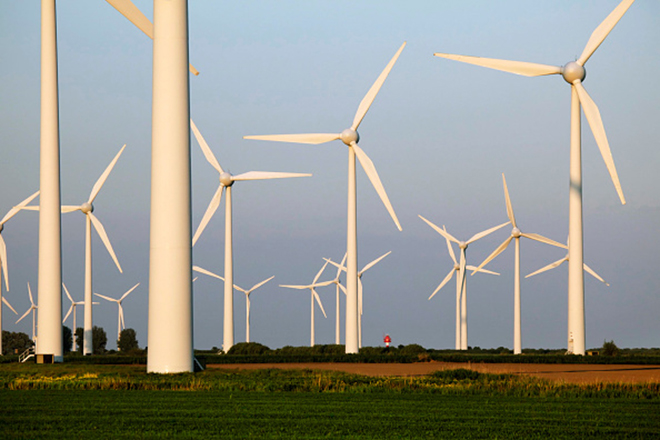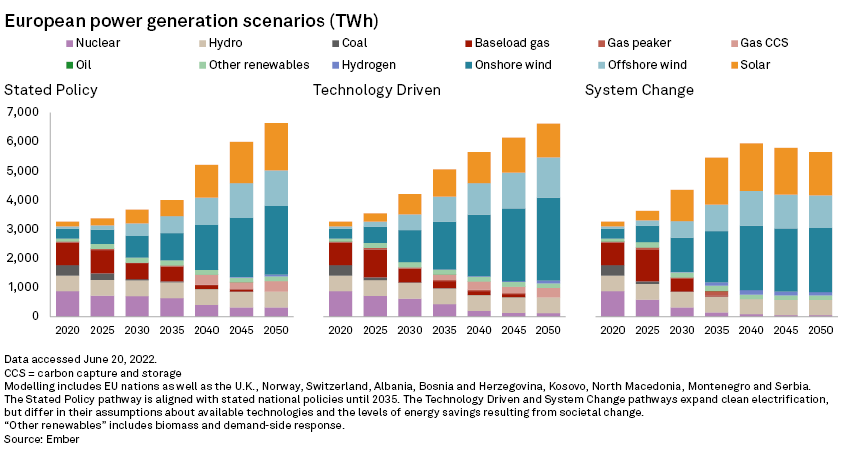
| A wind farm in Germany. Europe is aiming to accelerate renewables deployment as it looks to shift away from Russian energy imports. |
In Europe, an almost entirely clean power system is achievable by 2035 at no additional cost beyond existing commitments, including halving fossil fuel consumption by the end of this decade and quadrupling wind and solar capacity, according to a June 22 report.
While accelerated decarbonization would require higher up-front investments of up to €750 billion, these would be offset by as much as €1 trillion in savings by 2035 from avoided fossil fuel consumption, energy and climate change think tank Ember said in its New Generation study.
For wind and solar to reach up to 80% generation, annual deployment must be in the range of 100 GW to 165 GW from 2025, Ember researchers said, compared to an average growth of 24 GW per year in the 2010s. That would increase Europe's wind fleet fourfold to 800 GW by 2035 and solar by as much as nine times to 1,400 GW — a "win-win-win," according to Chris Rosslowe, senior energy analyst at Ember.
"It will save money, put Europe on track for its climate commitments and reduce its reliance on imported fossil fuels," Rosslowe said in a statement. "Europe should invest now for a huge payback by 2035."

The release of the report comes ahead of a Group of Seven summit in Germany on June 26, where leaders are expected to commit to achieving a "predominantly decarbonized" electricity system by 2035 and the eventual phaseout of unabated domestic coal generation.
It also comes amid a fundamental shift in Europe's energy landscape brought about by Russia's invasion of Ukraine. Since the war began, the European Union and national European governments have taken steps to increase their renewables ambitions as a means of reducing their reliance on Russian energy imports.
Under Ember's Stated Policy pathway, which aligns with existing government plans, wind and solar would only grow to 45%-65% of the capacity required by 2035. However, the scenario is based on data from October 2021 and therefore does not capture any policy updates caused by the war.
For instance, in the EU, the bloc's strategy to end its dependence on Russian energy — known as REPowerEU — goes "a long way to closing the gap between stated ambition and the pathways to 2035 clean power," Ember said.
The think tank said the renewables targets contained within the REPowerEU strategy — 510 GW of wind and 600 GW of solar by 2030 — broadly put the EU on course to achieve a clean power sector by 2035. Still, the targets require rapid deployment of capacity that far exceeds national plans and short-term market outlooks.
Ramping up installations also hinges on accelerating and simplifying permitting procedures for wind and solar — something that the REPowerEU strategy aims to do.

The Ember report said coal generation must be phased out by 2030 to align Europe's power system with the Paris Agreement on climate change and its goal of limiting global warming to 1.5 degrees C. At the same time, unabated gas must reduce to less than 5% of generation by 2035.
If Europe's full potential of electrification and energy savings can be realized, the continent's total consumption of fossil fuels would halve by 2030 — a greater reduction than the REPowerEU plan, Ember said.
The researchers only see a small role for gas with carbon capture and storage technology, while new nuclear plants are not found to be cost-competitive with Ember's modeled pathways. However, developing new nuclear according to existing national ambitions does not lead to higher system costs and helps reduce Europe's reliance on gas, Ember said.
The think tank's modeling suggests Europe can operate a 95% clean power system by 2035 without compromising on reliability and that the intermittent nature of wind and solar does not pose a threat to the grid's resilience. Interconnections, hydrogen electrolyzers and clean dispatchable sources such as hydro or low-emission gases are described by Ember as "the cornerstones of flexibility."
"It's time for Europe to roll up its sleeves," said Charles Moore, Ember's Europe lead. "Europe has shown it can step up its ambition in the face of the gas crisis and [Russian President Vladimir] Putin's fossil-fueled war. It is now required to keep pushing forward, to avert the climate crisis and unlock countless benefits for citizens and businesses."
S&P Global Commodity Insights produces content for distribution on S&P Capital IQ Pro.



